|
|
|
Sort Order |
|
|
|
Items / Page
|
|
|
|
|
|
|
| Srl | Item |
| 1 |
ID:
183260
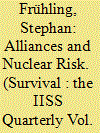

|
|
|
|
|
| Summary/Abstract |
There is a fundamental tension between the Biden administration’s stated intent to strengthen US alliances while at the same time reducing the role of US nuclear weapons. The credibility of extended-deterrence commitments – which in times of great-power conflict lie at the heart of US alliances – hinges on US allies and adversaries believing that Washington would resort to nuclear weapons to defend the core interests of its allies. A no-first-use or sole-purpose declaration would undermine deterrence and alliances by qualifying US security guarantees. The Biden administration and US allies should focus on coupling allied security to the threat of US nuclear use, to risks of inadvertent escalation for adversaries, and to the value of limited nuclear use in addressing conventional military imbalances in the Indo-Pacific. Forward-basing US nuclear forces in the region, where they are currently absent, is key to achieving all three of these aims.
|
|
|
|
|
|
|
|
|
|
|
|
|
|
|
|
| 2 |
ID:
157894
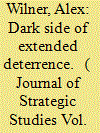

|
|
|
|
|
| Summary/Abstract |
States employ extended deterrence to shield third parties from aggression. The concept is traditionally applied to interstate relations, collective security arrangements, and strategic considerations. The protective relationship that exists between a state sponsor of terrorism and its non-state militant proxy is rarely considered. This article will introduce and explore the sponsor–proxy relationship in the context of extended deterrence, and relate it to Iran’s support and sponsorship of political violence, militancy, and terrorism in Europe. The article reviews the rationale states have for sponsoring terrorism, and illustrates the promises and pitfalls associated with extending deterrence to non-state militants.
|
|
|
|
|
|
|
|
|
|
|
|
|
|
|
|
| 3 |
ID:
192534
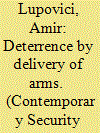

|
|
|
|
|
| Summary/Abstract |
During the course of the war in Ukraine, various actors have employed a unique type of deterrence by denial: namely, the threat to deliver arms. NATO leaders have committed—through rhetoric and deeds—to continue to deliver weapons to Ukraine if Russia escalated the war in order to deny Russian success. Not only is this type of strategy undertheorized, but it also challenges the distinction between direct and extended deterrence that has been central to deterrence scholarship. In deterrence by delivery of arms, the patron deters not by threatening to fight or deploy forces, but by committing to send weapons. However, the strategy also requires the protégé’s ability to fight. Studying deterrence by delivery of arms opens up understudied areas of deterrence (by denial), and provides a useful opportunity to consider how prominent concepts contribute to the research but also at times limit it.
|
|
|
|
|
|
|
|
|
|
|
|
|
|
|
|
| 4 |
ID:
166610
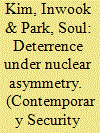

|
|
|
|
|
| Summary/Abstract |
The 2016 decision to deploy Terminal High Altitude Area Defense (THAAD) to South Korea has generated multitude of intensely politicized issues and has proved highly controversial. This has made it challenging to alleviate, let alone clarify, points of analytical and policy tensions. We instead disaggregate and revisit two fundamental questions. One is whether THAAD could really defend South Korea from North Korean missiles. We challenge the conventional “qualified optimism” by giving analytical primacy to three countermeasures available to defeat THAAD–use of decoys, tumbling and spiral motion, and outnumbering. These countermeasures are relatively inexpensive to create but exceedingly difficult to offset. Second, we assess the optimal way to ensure South Korean national security against North Korean missiles. By examining the balance of capability and issues of credibility/commitment, we show that the U.S. extended deterrence by punishment remains plentiful and sufficiently credible even without enhancing the current defense capability.
|
|
|
|
|
|
|
|
|
|
|
|
|
|
|
|
| 5 |
ID:
160348
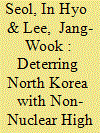

|
|
|
|
|
| Summary/Abstract |
The Republic of Korea (ROK) Ministry of National Defense (MND) should
support and guarantee the process of peaceful and diplomatic denuclearization
by providing a perfect deterrence posture that can cope with any contingencies,
while being especially cautious so as not to ignite political tensions. For that
purpose, strengthening the ROK’s own deterrence capability against the North
Korean military threat is becoming more and more important. This is especially
true because the North Korean ICBM capability, which is assessed to be completed
in a short time, is believed to be able to pose the so-called “decoupling situation”
on the Peninsula, by an increasing number of people. Although it is not certain
the decoupling may really happen even if the North does finally achieve ICBM
capability, this is a problem that cannot be ignored, since more and more people are
worrying about it. Several non-nuclear high-tech weapon systems and masterful
tactics to apply them in the Korean situation raise the possibility of dramatically
strengthening the overall deterrence posture against North Korean threat without
any additional nuclear measures. From now on, the ROK MND should formulate
a new version of the ROK’s own deterrence strategy against the North, the “3K+”
which tries to utilize the new possibilities provided by several conventional hightech
weapons, together with the pre-existing 3K systems (Kill Chain, KAMD, and
KMPR). The new strategy should be built more systematically to overwhelm any
possible North Korean military ambitions in advance, defeating any and all military
capabilities that the North is expected to strive for in the future. As Sun Tzu taught,
the highest strategy can frustrate the enemy into surrendering, even without a fight.
|
|
|
|
|
|
|
|
|
|
|
|
|
|
|
|
| 6 |
ID:
140025
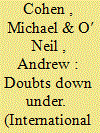

|
|
|
|
|
| Summary/Abstract |
American extended deterrence commitments span the globe. Despite extensive research on the causes of deterrence successes and failures, evidence of which US allies find what extended deterrence commitments credible is elusive. This article utilizes interviews with former Australian policy-makers to analyze the credibility of the United States to defend Australian forces during the 1999 INTERFET intervention in East Timor. While there was no direct threat to Australian sovereignty, the episode stoked concerns in Canberra regarding the willingness of Washington to come to Australia's assistance. The Howard government coveted a US tripwire force presence, and the Clinton administration's unwillingness to provide this raised serious concerns among Australian political elites about the alliance. While this says little about the separate question of whether Washington would use nuclear or conventional weapons in defense of Australian sovereignty, the Timor case indicates the existence of an extended deterrence credibility deficit regarding the more probable low-intensity conflicts that Australia finds itself in.
|
|
|
|
|
|
|
|
|
|
|
|
|
|
|
|
| 7 |
ID:
166862
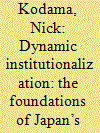

|
|
|
|
|
| Summary/Abstract |
Many have suggested that the true purpose behind Japan’s development of a closed nuclear-fuel cycle is to maintain the technical potential to develop nuclear weapons. However, closer examination of the development of Japan’s nuclear industry shows that, although Japan possesses advanced nuclear technologies, there has been no deliberate strategy to create a nuclear-weapon option. There is no “nuclear hedge.” To illustrate this point, this article presents a framework called “dynamic institutionalization” to explain the origins of Japan’s nuclear policies and the different sets of institutionalized pressures and constraints that have perpetuated these policies over time. Japan’s continued development of closed fuel-cycle technologies is primarily driven by domestic politics and the lack of a permanent spent-fuel management solution. On the other hand, Japan’s institutionalized nuclear forbearance is driven by the calculation that, as long as US extended deterrence remains credible, Japan’s security is best guaranteed through reliance on the US nuclear umbrella. By analytically untangling the policy of closed fuel-cycle development from the rationale for nuclear forbearance, this article provides a more nuanced view of the relationships between the domestic and international variables shaping Japan’s nuclear policies.
|
|
|
|
|
|
|
|
|
|
|
|
|
|
|
|
| 8 |
ID:
146626
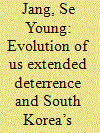

|
|
|
|
|
| Summary/Abstract |
Extended deterrence has been a main pillar of the security alliance between the United States and South Korea (Republic of Korea [ROK]) since the end of the Korean War. The changing dynamics of US extended deterrence in Korea, however, affected Seoul’s strategic choices within its bilateral alliance relationship with Washington. Examining the evolution of US extended deterrence in the Korean Peninsula until the Nixon administration, this article explains why South Korea began its nuclear weapons programme in a historical context of the US–ROK alliance relationship. This article argues that President Park Chung-hee’s increasing uncertainty about the US security commitment to South Korea in the 1960s led to his decision to develop nuclear weapons in the early 1970s despite the fact that US tactical nuclear weapons were still stationed in South Korea.
|
|
|
|
|
|
|
|
|
|
|
|
|
|
|
|
| 9 |
ID:
183162
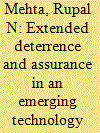

|
|
|
|
|
| Summary/Abstract |
How do emerging technologies impact strategic stability in the international system? I focus on how one aspect of strategic stability, extended deterrence commitments inherent to alliances, may be impacted by the development of new technologies and capabilities. I ask how technological innovations will impact the market deterrence and assurance dynamics in particular. I argue that while technologies may enhance the ability to provide extended deterrence, allies may be less assured by these new capabilities. To test these hypotheses, I explore emerging capabilities in new domains such as drones and hypersonic glide vehicles on international stability.
|
|
|
|
|
|
|
|
|
|
|
|
|
|
|
|
| 10 |
ID:
102388
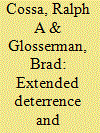

|
|
|
|
|
| Publication |
2011.
|
| Summary/Abstract |
Members of the Japanese government and the Japanese security elite welcomed the 2010 US Nuclear Posture Review (NPR) Report, praising its emphasis on the twin goals of pursuing disarmament and protecting international peace and stability. Unlike many non-nuclear weapon states, Japan does not condition its support for nonproliferation upon nuclear weapon states' progress on denuclearization. Despite general enthusiasm for the review in Japan, concerns remain. The NPR emphasizes the threat posed by nuclear weapons in the hands of non-state actors; from Japan's vantage point, state actors-North Korea, China, and Russia-are just as worrisome. While disarmament advocates in Japan had hoped the NPR would endorse a no-first-use doctrine or "sole purpose" declaration, defense officials and strategists were relieved it did not go that far, fearing that to do so would undermine US extended deterrence and leave Japan vulnerable to attack by North Korean biological or chemical weapons. US policy toward China shadows many Japanese concerns about security policy in general and nuclear policy in particular. In the absence of more clarity on the Sino-US relationship, Japanese concerns can be expected to increase. Nonetheless, the Japanese government has responded positively to the release of the NPR, in large part due to unprecedented levels of coordination and consultation between Tokyo and Washington during the drafting process. Tokyo now seeks continued close consultation on nuclear strategy and policy to develop a better understanding of the concept of extended deterrence and what Tokyo can do to support this shared goal.
|
|
|
|
|
|
|
|
|
|
|
|
|
|
|
|
| 11 |
ID:
146629
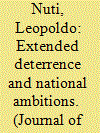

|
|
|
|
|
| Summary/Abstract |
Throughout the Cold War, Italy was one of the most steadfast NATO allies in hosting American nuclear weapons on its territory. Such a policy could easily be construed as an example of almost automatic confidence in the US nuclear umbrella, yet only on the surface did extended deterrence appease Italian anxieties about the uncertainties of the American nuclear guarantee. The Italian rationale for accepting a large array of US nuclear weapons did as a matter of fact involve a complex mix of reasons, ranging from trying to ensure that the Italian government would be consulted in the event of a major crisis, to willingness to enhance the country’s profile inside any Western multilateral fora. The paper will investigate this policy by looking at how the Italian government behaved at the height of the NATO nuclear sharing debate, between 1957 and 1962, arguably one of the historical moments in the Cold War when the concept of extended deterrence was most intensely discussed. Drawing up on hitherto classified archival sources as well as on some less-known public ones, the paper will show how Italian diplomats, military leaders and policymakers understood the dangers and political implications of US nuclear policies. It will, hopefully, demonstrate that Italy’s persistent search for a multilateral solution to the nuclearisation of NATO strategy shows that Italy never saw extended deterrence as a solution per se, but only as a temporary means to an end.
|
|
|
|
|
|
|
|
|
|
|
|
|
|
|
|
| 12 |
ID:
115296
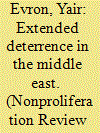

|
|
|
|
|
| Publication |
2012.
|
| Summary/Abstract |
The article presents and analyzes the US extended deterrence commitments in the Middle East as well as those provided by regional states, and assesses the effectiveness and credibility of these commitments. The article then proceeds to analyze a situation wherein Iran successfully develops nuclear weapons. It considers first the security requirements and alternatives of Gulf Cooperation Council (GCC) states, and then proceeds to assess the stability-or instability-of an Israeli-Iranian nuclear balance. The enhancement of US extended deterrence in the region is required in order to deter Iran, reassure allies, and contribute to the stability of an Israeli-Iranian nuclear balance. The article also discusses several contextual issues, such as: the future form of US extended deterrence; distinguishing between the latter and other US extended deterrence commitments; and the different approaches of specific GCC states and Israel.
|
|
|
|
|
|
|
|
|
|
|
|
|
|
|
|
| 13 |
ID:
119066
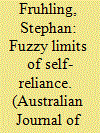

|
|
|
|
|
| Publication |
2013.
|
| Summary/Abstract |
As a close US ally, Australia is often seen as a recipient of US extended deterrence. This article argues that in recent decades, Australian strategic policy engaged with US extended deterrence at three different levels: locally, Australia eschews US combat support and deterrence under the policy of self-reliance; regionally, it supports US extended deterrence in Asia; globally, it relies on the US alliance against nuclear threats to Australia. The article argues that in none of these policy areas does the Australian posture conform to a situation of extended deterrence proper. Moreover, when the 2009 White Paper combines all three policies in relation to major power threats against Australia, serious inconsistencies result in Australia's strategic posture-a situation the government should seek to avoid in the White Paper being drafted at the time of writing.
|
|
|
|
|
|
|
|
|
|
|
|
|
|
|
|
| 14 |
ID:
146625
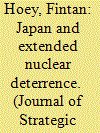

|
|
|
|
|
| Summary/Abstract |
To an observer, Japan’s approach to nuclear weapons can appear confused and contradictory. The only country to have been attacked with nuclear weapons is variously described as a pacifist and non-nuclear nation and as a proliferation threat. These widely varied and conflicting conclusions are understandable given that conflicting messages are sent by senior figures. However Japan’s stance is in fact a coherent, if not uncomplicated, response both to its security needs and to domestic public opinion. However, the security provided by US extended nuclear deterrence underlines and enables this approach. The key policies and decisions were taken in both Washington and Tokyo between China’s first nuclear test (1964) and Japan’s ratification of the Nuclear Non-Proliferation Treaty (1976). How the United States came to offer this additional security guarantee to Japan and how Japan came to rely upon it underscore this complex stance and are crucial to understanding a longstanding and ongoing security arrangement and source of stability and security in northeast Asia.
|
|
|
|
|
|
|
|
|
|
|
|
|
|
|
|
| 15 |
ID:
174732
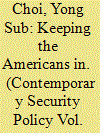

|
|
|
|
|
| Summary/Abstract |
Seoul and Washington have conceded that Terminal High Altitude Area Defense (THAAD) in South Korea cannot protect the capital region of Republic of Korea (ROK), including Seoul and Incheon, from North Korea’s missile attacks. Why did the South Korean government decide to deploy THAAD, risking possible retaliation from China, although it already knew its limited utility on the Korean peninsula? This article addresses the puzzle by connecting the deployment of THAAD in South Korea with the U.S. conception of a strategic rebalancing to Asia. By linking South Korea’s decision to deploy THAAD with contemporary alliance politics, extended deterrence, and abandonment and entrapment risks, it argues that Seoul’s THAAD decision was primarily intended to sustain and strengthen the U.S.-ROK alliance amid escalating nuclear threats by North Korea and deepening Sino-American rivalry.
|
|
|
|
|
|
|
|
|
|
|
|
|
|
|
|
| 16 |
ID:
152377
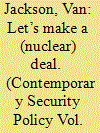

|
|
|
|
|
| Summary/Abstract |
An institutional perspective on nuclear deterrence cooperation within alliances has the potential to fundamentally reorient how we think about analyzing nuclear and deterrence decision-making between nuclear patrons and non-nuclear clients. It comes at a time when the presidency of Donald Trump is sure to test many of the core claims and assumptions in security studies, especially relating to bargaining and credibility within alliances. This article surveys questions that will be core to the research agenda involving alliance institutions and nuclear weapons during the Trump presidency and beyond.
|
|
|
|
|
|
|
|
|
|
|
|
|
|
|
|
| 17 |
ID:
156084
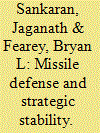

|
|
|
|
|
| Summary/Abstract |
South Korea is threatened by its troubled relationship with North Korea. North Korea possesses a large cache of missiles as well as chemical and biological weapons, and the future potential to mount nuclear weapons on its missiles. The United States is also challenged because of its defense commitments to Seoul. As a countermeasure, the United States and South Korea decided to deploy Terminal High Altitude Area Defense (THAAD) missile defenses in South Korea. However, China has objected. Chinese scholars believe the THAAD radar would be able to track Chinese inter-continental ballistic missiles, thereby weakening their deterrent. A technical analysis does not support this assertion. However, it is vital for South Korea, given its proximity and economic interdependence, to reassure China. South Korea should highlight that THAAD will be deployed by the United States Forces Korea and is not a commitment by Seoul to become part of U.S.-led missile defenses in the Asia-Pacific.
|
|
|
|
|
|
|
|
|
|
|
|
|
|
|
|
| 18 |
ID:
072555
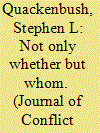

|
|
|
|
|
| Publication |
2006.
|
| Summary/Abstract |
Although in reality, states simultaneously pursue direct and extended deterrence, extant theories of deterrence have considered direct and extended deterrence situations separately. Furthermore, extended deterrence theories have not modeled all three actors in extended deterrence situations. To overcome these limitations in the literature, the author develops the three-party extended deterrence game and analyzes it with both complete and incomplete information, allowing conclusions to be drawn regarding deterrence and the related areas of alliance reliability and war expansion. For example, the findings indicate that deterrence is most likely to succeed when the alliance between Defender and Protégé is reliable. However, neither Defender nor Protégé wishes to be a more reliable ally than the other; if there is an asymmetry in reliability, Challenger will chose the more reliable state to attack in order to avoid a multilateral war. This counterintuitive conclusion was only reached by considering all three actors in extended deterrence.
|
|
|
|
|
|
|
|
|
|
|
|
|
|
|
|
| 19 |
ID:
123119
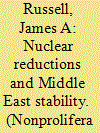

|
|
|
|
|
| Publication |
2013.
|
| Summary/Abstract |
The United States faces a series of strategic and policy conundrums as it attempts to promote strategic stability in the Persian Gulf and the wider Middle East. This article examines the relationship between a reduced US nuclear arsenal and strategic stability in the Persian Gulf and the Middle East. It argues that a series of interrelated political and military factors play a much more significant role in regional security and stability than the US strategic arsenal, which has never, with a few extraordinary exceptions, played a direct role in maintaining regional security. The United States has constructed a system of regional stability based on conventional deterrence and defense that has seen it forward base forces at various installations in the region in combination with efforts to arm, train, and equip host-nation militaries. Nuclear weapons have never played a prominent role in this regional system. Evidence presented in this article suggests that there is no compelling reason for the United States to abandon and/or modify the defensive system of conventional deterrence and defense by adding nuclear-backed guarantees to the mix.
|
|
|
|
|
|
|
|
|
|
|
|
|
|
|
|
| 20 |
ID:
090864
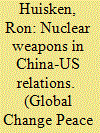

|
|
|
|
|
| Publication |
2009.
|
| Summary/Abstract |
Following the revival of interest in a deliberate process of reduction in the nuclear arsenals, eventually to zero, this article looks at a dimension of this challenge that has been overshadowed by the Cold War US-Soviet/Russia nuclear relationship and its legacy, namely, how nuclear weapons have figured in the relationship between the US and China. The topic highlights itself both because East Asia exemplifies the full range of challenges that confront the quest for nuclear disarmament and because the US-China relationship has been singled out as likely to be the defining relationship of this century.
|
|
|
|
|
|
|
|
|
|
|
|
|
|
|
|
|
|
|
|
|